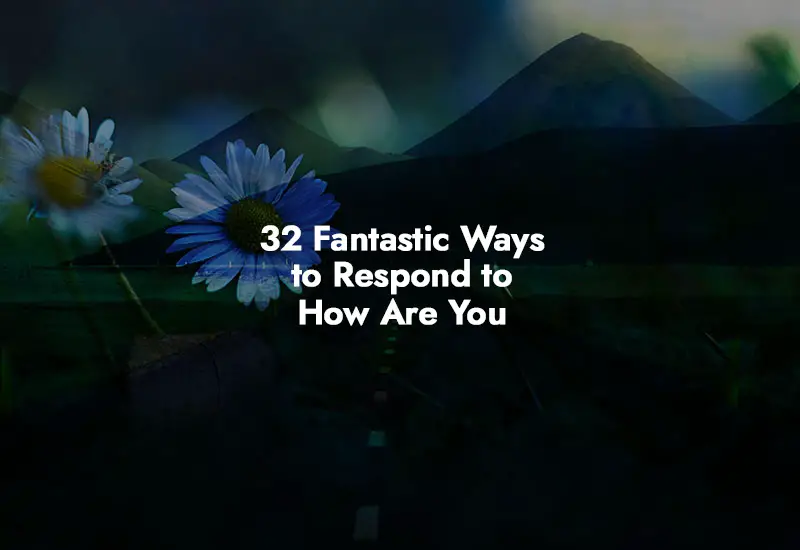When asked how you are, respond with a simple “I’m good, thanks” or “I’m doing well, how about you?” In our daily interactions, it is common for people to ask us how we are doing.
This seemingly simple question can sometimes leave us wondering how to respond. While there are numerous ways to answer, it is often best to keep it brief and straightforward. Saying something like “I’m good, thanks” or “I’m doing well, how about you?
Not only conveys that you are feeling fine, but also shows that you are interested in the other person’s well-being. By adhering to these simple responses, you can easily navigate this common social exchange with grace and ease.
- “I’m doing well, thank you.”
- “Not too bad, how about yourself?”
- “Pretty good, thanks for asking. How are you?”
- “I’m great, and you?”
- “Doing fine, how about you?”
- “Not too shabby, how’s your day going?”
- “I’m hanging in there, thanks. How are you doing?”
- “Fantastic, thanks! What about you?”
- “Could be better, but I’m getting by. How about you?”
- “I’m good, and you?”
- “Surviving the day, how about you?”
- “So far, so good. How are you?”
- “Not bad at all. How’s everything on your end?”
- “I’m alright, how about yourself?”
- “I’ve had better days, but I’m okay. How are you?”
- “Things are going well, thanks for asking. How about you?”
- “Pretty decent, how’s your day going?”
- “I’m fine, and you?”
- “Could be worse, but I’m hanging in there. How are you doing?”
- “Not too much to complain about. How about you?”
- “I’m doing great, thanks! How about yourself?”
- “I’m managing, how about you?”
- “I’m on cloud nine, thanks! How are things with you?”
Understanding The Different Types Of ‘How Are You’
When someone asks, “How are you?” it may seem like a simple question, but there are actually different types of this greeting. Understanding these variations can help you respond appropriately and build better connections with others. In this section, we will explore three common types of ‘How are you’: the casual greeting, the genuine inquiry, and the emotional check-in.

The Casual Greeting
The casual greeting is a common form of ‘How are you’ that you may encounter every day. It is often used as a simple salutation, where the person saying it doesn’t expect a detailed response. This type of ‘How are you’ is usually a polite way to start a conversation or acknowledge someone’s presence.
When responding to a casual greeting, keep your reply light and concise. You can say something like:
- I’m doing well, thank you!
- Great, how about you?
- Not too bad, and yourself?
Remember, the goal here is to keep the conversation flowing without diving into personal details. These brief responses show politeness and keep the interaction positive.
The Genuine Inquiry
Unlike the casual greeting, the genuine inquiry is a ‘How are you’ that shows sincere interest in your well-being. This type of question often comes from close friends or family members who genuinely care about your welfare.
When someone asks you a genuine inquiry, take this as an opportunity to share a bit more about your life. Your response should reflect honesty and openness. For example:
I’m doing well! Just started a new job, and I’m really enjoying it. How about you? Is everything going smoothly on your end?
By providing a meaningful answer, you validate the person’s concern and strengthen your bond. However, be mindful of the situation and the depth of the relationship. It’s unnecessary to share personal struggles with acquaintances or colleagues.
The Emotional Check-in
The emotional check-in is a ‘How are you’ that goes beyond surface-level conversation. It’s typically asked when someone senses that you may be going through a tough period emotionally or mentally. This type of question aims to provide support and show genuine care.
When responding to an emotional check-in, it’s important to be authentic and vulnerable if you feel comfortable doing so. Express your feelings honestly and reach out for support if necessary. For instance:
I’m glad you asked. Honestly, I’ve been feeling a bit overwhelmed lately. Would you mind talking about it for a moment?
By opening up, you allow others to be there for you, fostering deeper connections and potentially receiving the support you need.
Crafting Authentic Responses
When someone asks the common question, “How are you?” it can sometimes feel like an automatic greeting rather than a genuine inquiry. However, crafting authentic responses can transform this small talk into meaningful conversations. Below, we explore three key aspects to consider: reflecting on your feelings, tailoring your response to the situation, and practicing active listening.
Reflecting On Your Feelings
Before responding to the question, take a moment to genuinely reflect on your feelings. This self-awareness allows you to provide a more authentic response. Consider how you truly feel physically, emotionally, and mentally. Be honest with yourself so you can be honest with others.
Engaging in self-reflection is particularly important as it fosters a deeper connection with the person asking and opens the door for more meaningful conversations. For example, instead of a generic response like “I’m fine,” you could say something like “I’m feeling a bit tired today, but excited about a project I’m working on.” This not only reflects your true emotions but also provides an opportunity to share and connect on a more personal level.
Tailoring Your Response To The Situation
In addition to reflecting on your feelings, it’s vital to tailor your responses to the specific situation. Consider the context and relationship you have with the person asking. Are they a close friend, a colleague, or an acquaintance? Understanding this will help you determine how much detail to share.
For instance, with close friends, you may feel comfortable sharing more about your experiences and thoughts. You can engage in a deeper conversation by elaborating on your response. On the other hand, with colleagues or acquaintances, it’s often best to keep your response concise and focus on positive aspects. This adaptability allows you to maintain appropriate boundaries while still being authentic.
Practicing Active Listening
When responding to “How are you?”, it’s equally important to practice active listening. By paying attention to the person’s tone, body language, and choice of words, you can better gauge their sincerity and interest in your response.
Active listening also involves asking follow-up questions and providing thoughtful responses. This demonstrates genuine interest and helps facilitate a more in-depth conversation. Additionally, by actively listening, you create an environment where the person feels valued and understood.
By crafting authentic responses, you transform a simple greeting into an opportunity for meaningful connection. Reflecting on your feelings, tailoring your response to the situation, and practicing active listening are key elements to consider. Incorporating these practices will not only deepen your relationships but also foster more engaging and fulfilling conversations.
Initiating Meaningful Conversations
When someone asks you “How are you?” it’s an opportunity to engage in a meaningful conversation that goes beyond a simple greeting. By initiating a more personal and open dialogue, you can create stronger connections with others and foster a sense of empathy and support. Here are three ways you can take the conversation further:
Asking Open-ended Questions
One effective way to deepen a conversation is by asking open-ended questions that allow the other person to share more about themselves. Instead of settling for a generic response, try asking questions like:
- “What have you been up to lately?”
- “Any exciting plans for the weekend?”
- “How do you unwind after a long day?”
These open-ended questions encourage the other person to reflect and provide more insightful answers, leading to a more meaningful conversation.
Sharing Personal Stories
Sharing personal stories can help you connect on a deeper level with the person who asked “How are you?” By opening up and sharing something about yourself, you create an atmosphere of trust and vulnerability. Consider sharing a relatable experience or a recent achievement that you’re proud of. This not only allows the other person to get to know you better but also encourages them to reciprocate and share their own stories.
Expressing Empathy And Support
Expressing empathy and support is crucial to effectively respond to the question “How are you?” It shows that you genuinely care about the other person’s well-being. You can offer words of encouragement, such as:
- “I hope you’re doing well and if there’s anything I can do to help, let me know.”
- “I understand how challenging things can be, and I’m here to listen if you need someone to talk to.”
- “Remember to take care of yourself, both physically and mentally. You’re important.”
By expressing empathy and support, you provide reassurance and let the person know that they are not alone.
More Ideas to Response
- “All good on my end, how about yours?”
- “Can’t complain, how’s your day treating you?”
- “Doing fine and dandy, thanks. How about yourself?”
- “Not too shabby, thanks for asking. How are things with you?”
- “I’m in a pretty good place right now, how about you?”
- “So far, so good. How about your day?”
- “I’m feeling positive today, thanks. How about you?”
- “Life’s treating me well at the moment, how about you?”
- “I’m on the upswing, how’s everything on your end?”
- “I’m managing to stay on the sunny side. How about yourself?”
Conclusion
Responding to “How are you” is an opportunity to connect with others on a deeper level. By being authentic and genuinely interested in the other person’s well-being, we can foster meaningful relationships. Remember, a simple question can lead to a powerful conversation.
So, next time someone asks you, take a moment to respond thoughtfully and leave a lasting impression.









